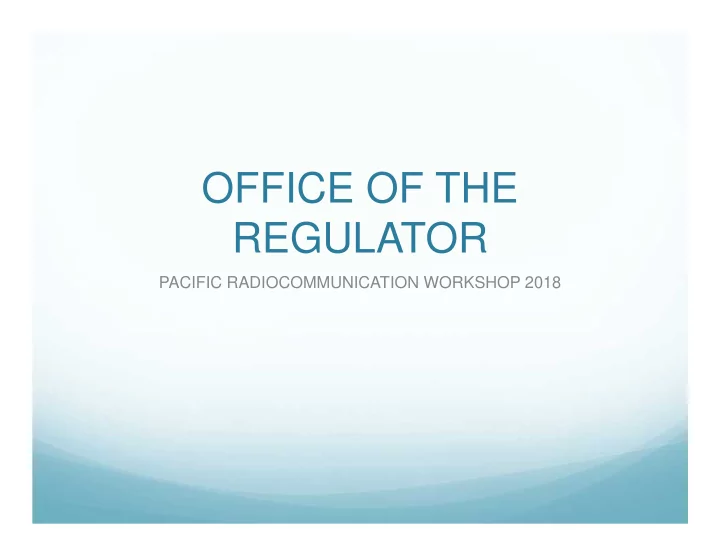

OFFICE OF THE REGULATOR PACIFIC RADIOCOMMUNICATION WORKSHOP 2018
Independent state of Samoa Independent State of Samoa Population – 198,926 (2015) Area – 2,831 sq km Currency – Tala Located: 13 o 48’04” S / 172 o 00’00” W • 9 islands with 4 main islands. Upolu and Savaii being the biggest and mainly habitat islands. Upolu – Apia Savaii – Salelologa Reference: Maps obtained from google maps.
OFFICE OF THE REGULATOR The Office of the Regulator is Samoa’s Regulator for the telecommunications, broadcasting, postal and electricity sectors. The Organisation was established in 2006 under the Telecommunications Act 2005 to provide regulatory services for the telecommunications sector in Samoa. However, the Broadcasting, Postal Services and Electricity Acts 2010 were subsequently approved by Parliament, which also provide regulatory framework for these sectors To facilitate and promote the best interests of consumers and participants in the ICT, postal and electricity sectors through the best combination of competition and effective regulation.
OOTR STRUCTURE Engineering Officer (Spectrum )
OOTR STRUCTURE 2. Electricity Division 1. Regulatory & Consumer Services electricity industry licensing, regulatory oversight,market analysis and consumer affairs functions in the sectors within electricity tariff determination, the mandate of the organization. establishing and monitoring electricity technical standards, and overseeing licensee compliance, market developing and enforcing monitoring, managing issues arising from anti- appropriate electricity sector competitive behaviour, price regulation, access and interconnection, consumer complaint regulations. resolution, quality of service and universal access. 3. Spectrum & Technical Services undertakes all spectrum management and technical duties of the organisation associated with the communications sector, including the monitoring of spectrum usage, interference complaints management, equipment type approval and numbering management. 5. Legal 4. Corporate Services ensures that the legal requirements provides support in administration, in the various legislation are finance, human resource and other complied with and provides legal corporate services to the Office. advice on all matters relating to the Office.
Spectrum & Technical Services Structure ACEO Spectrum and Technical Services Principal Spectrum & Principal Spectrum Principal Spectrum & Technical Officer Management System Technical Analyst Officer (Vacant) Engineering Officer (Spectrum)
Responsibilities Goals 1. Ensure effective and relevant Spectrum Management policies, procedures, systems and processes are in place Numbering Management for all services ie; spectrum management, numbering, ICT and postal services Type Approval 2. Regulate compliance of Develop Guidelines and service providers with policies on spectrum management, Procedures (Telecom, ICT and postal services. Broadcasting and Postal) 3. Provide capacity building Record Keeping programs for the Division on monitoring and regulatory roles for spectrum OOTR Building management of ICT and postal services. Management
REGULATORY FRAMEWORK LEGISLATION Telecommunications Act 2005 Broadcasting Act 2010 Electricity Act 2010 Postal Services Act 2010 REGULATIONS Telecommunications Telecommunication Licence Fee Amendment Regulation 2015 Broadcasting Broadcasting (License Fees) Regulations 2015 Radio Spectrum: Radio Spectrum Fees Amendment Regulations 2015 Electricity Electricity Fees Regulation 2017 ORDERS Telecommunications Order Electricity Order
REGULATORY FRAMEWORK cont’d. Telecommunications Frequency sharing (Customer protection) Rules 2017 Frequency planning and Type Approval Rule 2018 allocations Principal Frequency Frequency authorisation Assignment 2017 Universal access Samoa National Numbering Plan 2016 Frequency license and Samoa National usage fees with eligibility Frequency Allocation Table for fees exemption 2017 Short range devices Radio Spectrum Rule 2018 Frequency monitoring
Telecommunications Radio spectrum fees amendment regulations Act 2015 2015
Radio Frequency Allocation National Spectrum Management Plan For Samoa National Frequency Allocation Table 2017 Source: ITU Website
National Spectrum Licensing workflow Application Received Check application License Request Issue application fee Regulatory & LEGAL invoice EVALUATION TECHNICAL EVALUATION FINANCIAL Availability of Frequency EVALUATION No interference with adjacent channel Issue LICENSE Issue INVOICE CERTIFICATE (Annual Charge)
Market Structure Number of service providers 5 ISP BlueSky Samoa Ltd, Digicel Samoa Ltd, Computer Services Limited (CSL), NETVO, Lesa’s Telephone Services Number of mobile operators 2 BlueSky Samoa Ltd, Digicel Samoa Ltd
Market structure Internet and broadband services Business license required on operators Internet Service Provider License GSM spectrum license WiMAX Spectrum license (2 Service Provider) Satellite Earth Station license Number of internet users through broadband lines ( xDSL, LTE, 3G, WiMAX and satellite communications, etc.) Internet usage as of 2010 = 5.03% of population An increase of internet access from 2010 in comparison to data obtained from ITU website. Individuals using internet = 25.41% (from ITU website) Mobile cellular telephone subscribers= 58.52 per 100 inhabitants (from ITU website) Percentage of house holds with computer = 22.60% (form ITU website)
Market Structure Fibers Samoa Submarine Company Cable (SSCC), We also utilise Samoa American Samoa (SAS) cable for providing services such as the backhaul. FSS systems in use O3B Inmarsat / Iridium (Satellite Phone) Ku Band C Band & Ka Band
Example of spectrum allocation What Spectrum bands are in use for 3G/4G? ITU-R. Rec_M.1063: E-GSM900, GSM900, 1800 MHz Band APT700 and 3G 925-935 MHz paired with 880-890 MHz 950-960 MHz paired with 905-915 MHz 4G LTE 700: 703-748 MHz paired with 758-803 MHz: FDD LTE1800: 1710-1785 paired with 1805-1880 MHz: FDD LTE 1800: 1785 MHz to 1805 MHz : TDD (Government – SNBH Network) LTE 1900: 1920 to 1980 paired with 2110 to 2170 (1 ISP)
Tools Spectrum Monioring System Scorpio Software Mobile Automated Spectrum Management System SMS4DC R&S PR100 Receiver – Portable Receiver FSH-4 - Spectrum Analyser
Challenges Laboratory Test Radio Monitoring equipment Look after equipment properly Takes time and money to fix Staff Sometimes there is more work compared to the number of staff.
FA’AFETAI TELE LAVA.
Recommend
More recommend